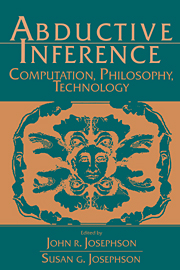Book contents
- Frontmatter
- Contents
- Contributors
- Introduction
- 1 Conceptual analysis of abduction
- 2 Knowledge-based systems and the science of AI
- 3 Two RED systems – abduction machines 1 and 2
- 4 Generalizing the control strategy – machine 3
- 5 More kinds of knowledge: Two diagnostic systems
- 6 Better task analysis, better strategy – machine 4
- 7 The computational complexity of abduction
- 8 Two more diagnostic systems
- 9 Better task definition, better strategy – machine 5
- 10 Perception and language understanding
- Appendix A Truth seekers
- Appendix B Plausibility
- Extended Bibliography
- Acknowledgments
- Index
Appendix A - Truth seekers
Published online by Cambridge University Press: 08 October 2009
- Frontmatter
- Contents
- Contributors
- Introduction
- 1 Conceptual analysis of abduction
- 2 Knowledge-based systems and the science of AI
- 3 Two RED systems – abduction machines 1 and 2
- 4 Generalizing the control strategy – machine 3
- 5 More kinds of knowledge: Two diagnostic systems
- 6 Better task analysis, better strategy – machine 4
- 7 The computational complexity of abduction
- 8 Two more diagnostic systems
- 9 Better task definition, better strategy – machine 5
- 10 Perception and language understanding
- Appendix A Truth seekers
- Appendix B Plausibility
- Extended Bibliography
- Acknowledgments
- Index
Summary
Abduction machines
In this book, we described six generations of abduction machines. Each generation's story was told by describing an abstract machine and experiments with realizations of the machine as actual computer programs. Each realization was approximate, partial, something less than a full realization of the abstract machine. Each realization was also more than the abstract machine: an actual chunk of software, a knowledge-based expert system constructed to do a job, with an abundance of insights, domain-specific solutions, and engineering shortcuts to get the job done. The abstract machines are simplified idealizations of actual software.
An abstract abduction machine is a design for a programming language for building knowledge systems. It is also a design for a tool for constructing these systems (a partial design, since a tool also has a programming environment).
Each of the six machines has a strategy for finding and accepting best explanations. Machine 6 inherits all the abilities of the earlier machines. Suppose that we connect it to abstract machines for the subtasks of hypothesis matching, hierarchical classification, and knowledge-directed data retrieval (see chapter 2). Then we conjoin abstract machines able to derive knowledge for various subtasks from certain forms of causal and structural knowledge (see chapters 5 and 8). Then we implement the whole abductive device as a program written for a problem-solving architecture, which is an abstract device of a different sort that provides control for generalized, flexible, goal-pursuing behavior (see chapter 4).
- Type
- Chapter
- Information
- Abductive InferenceComputation, Philosophy, Technology, pp. 262 - 265Publisher: Cambridge University PressPrint publication year: 1994



